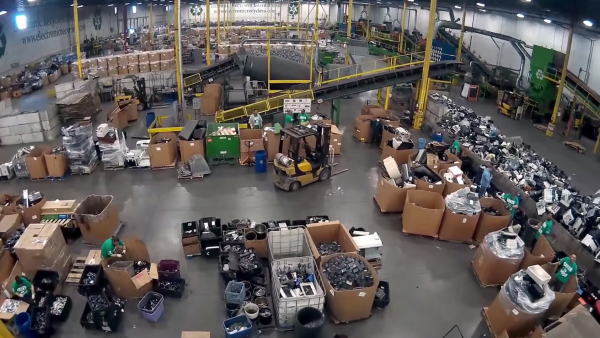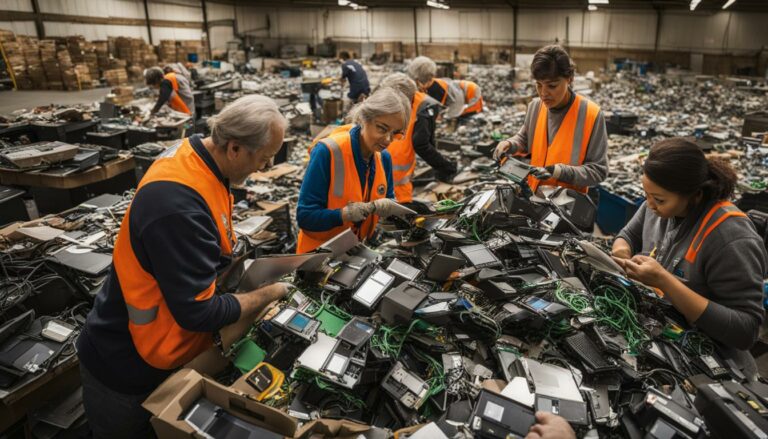Effective Strategies for Corporate IT Recycling
Effective Strategies for Corporate IT Recycling have become a cornerstone for businesses aiming to achieve both environmental sustainability and cost efficiency. In today’s digital age, corporations generate a significant amount of electronic waste, ranging from outdated computers to obsolete servers. This e-waste not only poses environmental risks but also represents a missed opportunity for resource recovery and potential revenue.
This article aims to shed light on effective strategies for corporate IT recycling, offering a comprehensive guide for businesses looking to navigate the complexities of IT asset disposition. From the initial stages of auditing your IT equipment to choosing the right recycling partner, we will cover all the essential aspects to help you implement a successful IT recycling program.
Auditing Your IT Assets: The First Step in Corporate IT Recycling
Embarking on the journey of Effective Strategies for Corporate IT Recycling begins with a comprehensive audit of your existing IT assets. This audit serves as the cornerstone for making informed decisions about recycling, repurposing, or responsibly disposing of your IT equipment.
Importance of IT Asset Auditing
An IT asset audit is more than just an inventory check; it’s a strategic activity that plays a vital role in responsible corporate IT recycling. The audit helps you identify:
- The age of your IT assets, which can determine their recyclability or resale value.
- The condition of the equipment, including any damages or wear that might affect its usability or value.
- Any potential data security risks associated with the devices, crucial for data security best practices in corporate IT recycling.
Tools and Software for IT Asset Auditing
In the age of digital transformation, various tools and software can significantly streamline the IT asset auditing process. These tools can:
- Automatically catalog all IT assets across your organization.
- Assess the condition and performance of these assets.
- Provide insights into the potential recyclability or resale value of the equipment, thereby contributing to more effective corporate IT recycling strategies.
Data Security Concerns
Data security is a paramount concern when auditing IT assets for recycling. Before any device leaves your premises for recycling or disposal, it’s crucial to:
- Securely erase all sensitive data.
- Ensure that the data erasure process complies with industry standards and regulations.
- Obtain certificates of data destruction as proof of secure data erasure, aligning with data security best practices in corporate IT recycling.
By taking the time to conduct a thorough IT asset audit, you set the stage for a successful corporate IT recycling program. This foundational step is not only essential for environmental sustainability but also for ensuring data security and compliance with regulations.
Choosing the Right Recycling Partner: A Critical Decision in Corporate IT Recycling
Selecting the right recycling partner is a pivotal element in the successful implementation of Effective Strategies for Corporate IT Recycling. This choice will have far-reaching implications, affecting not only the efficiency of your recycling program but also your company’s reputation and compliance with regulations.
Factors to Consider When Choosing a Recycling Partner
Certifications and Compliance
Ensure that your chosen recycling partner holds the necessary certifications and complies with both local and international regulations. This is not just a matter of legal obligation but also a cornerstone for legal compliance in corporate IT recycling.
Data Security Measures
Data security is paramount when it comes to IT recycling. Evaluate the data destruction and encryption methods employed by the recycling partner to align with the data security best practices in corporate IT recycling established during your IT asset auditing phase.
Environmental Impact
The environmental footprint of your recycling partner is another critical consideration. Ensure they employ sustainable methods in corporate IT recycling, such as zero landfill policies and energy-efficient operations.
Cost and Value Recovery
While cost shouldn’t be the sole deciding factor, consider the value recovery options offered by the recycling partner. Some companies provide buy-back or trade-in options for IT assets that still hold value, contributing to cost-effective solutions in corporate IT recycling.
Importance of Due Diligence
Due diligence involves checking references, reviewing case studies to understand the partner’s capabilities, and visiting the recycling facilities to assess their operations. A guide on responsible IT asset disposition can offer valuable insights into best practices for this crucial step.
Implementing a Corporate IT Recycling Program: Best Practices and Procedures
Once you’ve conducted a thorough IT asset audit and selected a reliable recycling partner, the next step is to implement your corporate IT recycling program. This section will guide you through the best practices and procedures to ensure a successful and sustainable initiative.
Planning and Logistics
The first step in implementing Effective Strategies for Corporate IT Recycling is planning. This involves:
- Determining the scope of the recycling program.
- Identifying the types of IT assets to be recycled.
- Setting up a timeline and milestones for the program.
Employee Training and Awareness
For a recycling program to be successful, it’s essential to involve your employees. Conduct training sessions to educate them on the importance of responsible IT asset recycling in a corporate setting.
Documentation and Record-Keeping
Maintaining accurate records is crucial for tracking the progress of your recycling program and for compliance purposes. This includes:
- Inventory lists of recycled assets.
- Certificates of data destruction.
- Receipts and documentation from the recycling partner.
Monitoring and Evaluation
Regularly monitor the program’s effectiveness by setting key performance indicators (KPIs). This allows you to make data-driven decisions and continuously improve your corporate IT recycling strategies.
By following these best practices and procedures, you can implement a robust and effective corporate IT recycling program. This not only contributes to environmental sustainability but also aligns with data security and compliance requirements.
The Future of Corporate IT Recycling: Trends and Innovations
As we move further into the digital age, the landscape of corporate IT recycling is bound to evolve. This section aims to delve deeper into the emerging trends and technological innovations that are set to redefine Effective Strategies for Corporate IT Recycling.
Circular Economy and IT Recycling
The circular economy model is increasingly becoming a focal point in sustainability discussions. This model emphasizes not just recycling but also the repurposing and refurbishing of IT assets. Companies are now exploring circular approaches in corporate IT recycling, which involve:
- Extending the lifecycle of IT assets through refurbishment.
- Creating take-back programs for consumers to return old devices.
- Partnering with suppliers committed to sustainable practices.
Technological Innovations
The role of technology in shaping the future of recycling is undeniable. Several groundbreaking technologies are emerging that promise to make corporate IT recycling more efficient and sustainable. These include:
- Machine learning algorithms that can sort e-waste materials with unprecedented accuracy.
- Blockchain technologies that offer transparent and immutable tracking of IT asset lifecycles.
- Advanced data destruction techniques that ensure data security while maximizing recyclability.
Regulatory Changes
As the environmental and social implications of e-waste become more pronounced, regulatory bodies are taking action. Companies must stay updated on these changes to ensure compliance in future corporate IT recycling initiatives. This involves:
- Regularly reviewing local, national, and international e-waste regulations.
- Implementing internal policies that exceed minimum regulatory requirements.
- Engaging in industry forums and government consultations to stay ahead of upcoming changes.
Global Partnerships
E-waste is a global issue that transcends national borders. As such, international collaborations are becoming more common to standardize corporate IT recycling practices across different countries. These partnerships aim to:
- Harmonize e-waste management standards.
- Facilitate the exchange of best practices.
- Encourage multinational corporations to adopt uniform recycling policies.
By staying abreast of these trends and innovations, companies can position themselves at the forefront of sustainable and effective corporate IT recycling. Adapting to these changes is not just a matter of compliance but also an opportunity to contribute to broader sustainability goals.
The Role of the Construction Industry in Corporate IT Recycling
This section could explore how the construction industry, often seen as resource-intensive, is making strides in corporate IT recycling. It could discuss how construction companies are increasingly adopting sustainable practices, including the recycling of IT equipment. This could range from repurposing old computers for on-site operations to recycling materials for smart buildings. The section could also highlight case studies or partnerships between IT recycling firms and construction companies.
Frequently Asked Questions (FAQs)
What Does IT Recycling Entail?
IT recycling involves the responsible management of electronic assets like computers, servers, and other devices, either by repurposing, refurbishing, or properly disposing of them.
Why is Auditing IT Assets Crucial?
Auditing your IT assets is the foundational step in any effective recycling strategy. It helps you understand what electronic items you have, their current condition, and any associated data security risks.
How Should I Select a Recycling Partner?
Choosing a partner for your recycling needs involves multiple considerations, including certifications, data security protocols, and their commitment to environmental sustainability.
What Trends are Shaping the Future of IT Recycling?
Emerging trends include the rise of the circular economy, technological innovations for sorting and tracking e-waste, and evolving regulations aimed at promoting responsible recycling practices.
How Can Staff Members Contribute to Recycling Efforts?
Employee involvement is key to the success of any recycling program. This can be achieved through training sessions and adherence to the company’s established recycling policies and procedures.
Conclusion: The Path Forward in Corporate IT Recycling
As we’ve explored throughout this article, implementing Effective Strategies for Corporate IT Recycling is a multi-faceted endeavor that requires careful planning, due diligence, and a commitment to continuous improvement. From conducting a thorough IT asset audit to choosing the right recycling partner and staying abreast of emerging trends, each step plays a crucial role in the success of your corporate IT recycling program.
The future holds promising advancements in technology and regulatory frameworks that will further shape the landscape of corporate IT recycling. By embracing these changes and integrating them into your recycling strategies, you can achieve not only compliance and data security but also contribute to global sustainability efforts.
It’s clear that corporate IT recycling is not just a corporate responsibility but also an opportunity for innovation and value creation. As we move forward, the companies that will stand out are those that approach IT recycling not as a challenge but as an opportunity to make a meaningful impact.
This concludes our comprehensive guide on Effective Strategies for Corporate IT Recycling. Thank you for taking the time to read, and we hope you found the insights valuable for your organization’s recycling initiatives.













